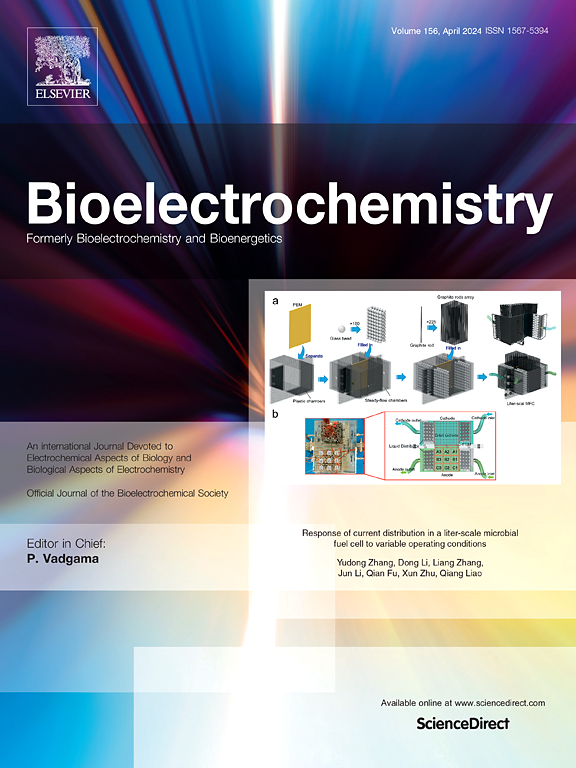CeO2@Co3O4-decorated carbon felt anode with mesoporous nanoparticles for enhanced POM wastewater treatment and electricity generation in microbial fuel cells
IF 4.8
2区 化学
Q1 BIOCHEMISTRY & MOLECULAR BIOLOGY
引用次数: 0
Abstract
Microbial fuel cells (MFCs) have been widely used in the treatment of organic wastewater because of its advantages of high efficiency, environmental friendliness, and no secondary pollution. In this study, we developed a composite anode, CeO2@Co3O4-PEDOT/CF (PEDOT: poly(3,4-ethylenedioxythiophene), CF: carbon felt), by incorporating bimesoporous CeO2@Co3O4 nanoparticles and PEDOT layer. The MFCs equipped with this novel anode had demonstrated exceptional catalytic performance in the treatment of Polyoxymethylene (POM) wastewater. Specifically, it achieved a 74.9 % increase in output voltage (586 ± 23 mV), a 2.5-fold increase in power density (3564 ± 27 mW/m2), and enhancements of 41.8 %, 40.1 %, and 47.0 % in the degradation rates of formaldehyde (HCHO, 97.2 %), 1,3,5-trioxane (TOX, 93.6 %), and chemical oxygen demand (COD) removal efficiency (84.4 %), respectively, when compared to a bare CF anode. Furthermore, the MFC with the composite anode demonstrated high degradation efficiency and COD removal efficiency across various industrial water environments. Additionally, the wheat seed germination experiments indicated a significant reduction in the toxicity of the degraded solution. This enhanced performance could be attributed to the synergistic effects of the bimesoporous CeO2@Co3O4 nanoparticles and the PEDOT layer. This study presents a promising strategy for the degradation of organic pollutants and the generation of bioelectricity in practical applications.
CeO2@Co3O4-decorated碳毡阳极与介孔纳米颗粒增强POM废水处理和发电的微生物燃料电池。
微生物燃料电池以其高效、环保、无二次污染等优点在有机废水处理中得到了广泛的应用。在本研究中,我们开发了一种复合阳极,CeO2@Co3O4-PEDOT/CF (PEDOT:聚(3,4-乙烯二氧噻吩),CF:碳毡),加入双孔CeO2@Co3O4纳米颗粒和PEDOT层。该新型阳极的mfc在处理聚甲醛(POM)废水中表现出优异的催化性能。具体而言,与裸CF阳极相比,输出电压(586±23 mV)提高了74.9%,功率密度(3564±27 mW/m2)提高了2.5倍,甲醛(HCHO, 97.2%)、1,3,5-三氧环(TOX, 93.6%)和化学需氧量(COD)去除效率(84.4%)分别提高了41.8%、40.1%和47.0%。此外,复合阳极的MFC在各种工业水环境中都表现出较高的降解效率和COD去除率。此外,小麦种子萌发实验表明,降解溶液的毒性显著降低。这种增强的性能可能归因于双孔CeO2@Co3O4纳米颗粒和PEDOT层的协同作用。该研究为有机污染物的降解和实际应用中的生物发电提供了一种有前途的策略。
本文章由计算机程序翻译,如有差异,请以英文原文为准。
求助全文
约1分钟内获得全文
求助全文
来源期刊

Bioelectrochemistry
生物-电化学
CiteScore
9.10
自引率
6.00%
发文量
238
审稿时长
38 days
期刊介绍:
An International Journal Devoted to Electrochemical Aspects of Biology and Biological Aspects of Electrochemistry
Bioelectrochemistry is an international journal devoted to electrochemical principles in biology and biological aspects of electrochemistry. It publishes experimental and theoretical papers dealing with the electrochemical aspects of:
• Electrified interfaces (electric double layers, adsorption, electron transfer, protein electrochemistry, basic principles of biosensors, biosensor interfaces and bio-nanosensor design and construction.
• Electric and magnetic field effects (field-dependent processes, field interactions with molecules, intramolecular field effects, sensory systems for electric and magnetic fields, molecular and cellular mechanisms)
• Bioenergetics and signal transduction (energy conversion, photosynthetic and visual membranes)
• Biomembranes and model membranes (thermodynamics and mechanics, membrane transport, electroporation, fusion and insertion)
• Electrochemical applications in medicine and biotechnology (drug delivery and gene transfer to cells and tissues, iontophoresis, skin electroporation, injury and repair).
• Organization and use of arrays in-vitro and in-vivo, including as part of feedback control.
• Electrochemical interrogation of biofilms as generated by microorganisms and tissue reaction associated with medical implants.
 求助内容:
求助内容: 应助结果提醒方式:
应助结果提醒方式:


